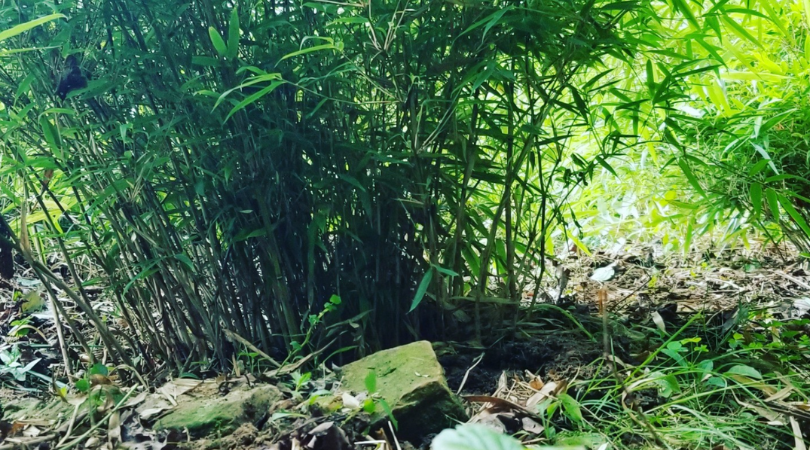Definitions:
Definitions:
Rhizome: is an underground plant stem that produces roots and shoots. Culm: a stem or stalk. Shoot: a young stem that is produced from a plant. Neck: a thick, underground stem that connects with other root systems. Subvariant: numerous forms of plants derived from the same variant. Trench: similar to a ditch, where it is long and deep in the ground.
Background
Background
Feelings About Bamboo
The word bamboo may have a lot of negative connotations to it, like scary, mad, dislike, frustrated, etc. All bamboo becomes terrible because of misinformation, assumptions about the entire bamboo species, and past experiences. There are two variants or kinds of bamboo, running and clumping. We will touch on these differences soon. Anyone living in suburban, rural, and city areas with bamboo almost always has running bamboo. Running bamboo spreads (invasive) like wildfire if not adequately managed.
When developers create further developments, it is the fastest, easiest, and most likely cost-effective means to separate and provide privacy from neighbors and neighborhoods. What developers might not do is provide preventative measures from enabling the running bamboo from spreading out of control. This is likely why the word bamboo is analogous to these negative feelings and emotions. The bamboo becomes a chore and tedious to prevent the spread. Some methods can be incorporated before and even after bamboo is planted. If you intend to plant running bamboo, it is best to do these preventative techniques before planting. Running bamboo can be beautiful and provides numerous applications to be used as products and tools. So, do the more intricate work first.
Grass Family
Bamboo is part of the grass family. The grass cut in every American’s front yard is within the same genome as bamboo. Taking a closer look at bamboo leaves, the similarities are undeniable. As many can attest, grass is resilient, yet tricky to sustain fresh, lush, green grass. So too, is bamboo. Grass varieties require maintenance and fertilizers.
Bamboo can ingest the same fertilizers the front yard loves to keep the vibrant green colors. Milorganite is an excellent substitute for other fertilizers because it is a slow and steady release of organic nutrients. It feeds the microorganisms, which in turn feed the plants. We typically like to use compost because it provides numerous other vital components to the soil food web, but this type is easy to work with for just getting started. Check out our other brief overview blog about composting.
Running vs. Clumping
Running vs. Clumping
Structure of Bamboo
Both bamboo varieties (running and clumping) are rhizomes, so they sit roughly within the top 6″ of the topsoil. The roots may penetrate approximately another 15″. Both running and clumping bamboo produce new rhizomes each year. This is how they repopulate. Bamboo does not grow fresh rhizomes throughout the year. They develop new shoots in the spring, producing culms that grow for roughly sixty days. During this time, they will grow in height and diameter, making vegetation (i.e., limbs and leaves). After this period, the new culms will not succeed in height or diameter for the remainder of their lifetime, but new shoots next year will grow higher and thicker. The bamboo will mature around five years, and the new shoots will grow to full height and diameter maturity every year. Each height and diameter depends on the subvariant of each bamboo plant. Both running and clumping have numerous other subvariants. Choose the perfect size and diameter maturity that suits each individual’s desires. After the sixty days, the bamboo will focus the remainder of the year’s energy on producing new rhizomes, creating new shoots the following year.
Running Bamboo
The significant difference between running (leptomorph rhizome) and clumping ( pachymorphy rhizome) is running bamboo will produce new rhizomes in a line, which connects to the original rhizome through the rhizome neck. Running bamboo uses this method by growing new necks approximately two to three feet away from each rhizome. This is why running bamboo is naturally invasive to a yard and property. You may be asking, well, why does it become a forest of bamboo? It is most likely due to developers or previous property occupants planting numerous rhizomes of running bamboo. Additionally, if running bamboo meets resistance in soil (e.g., rocks or other obstructions), it may penetrate through or grow around the obstacle, creating different avenues for the bamboo to spread.
Clumping Bamboo
Clumping bamboo grows in a completely different manner. It penetrates the soil within similar depths as running bamboo. However, it does not grow in a line, and it does not grow two to three feet per year. Phew! Clumping bamboo grows new necks approximately two to six inches away from each culm from the previous year. Think of how a hand has a center and fingers extending from the palm of each hand. This is how clumping bamboo grows new necks and rhizomes.
Clumping bamboo grows these fresh rhizomes that eventually encircle the original rhizome, creating a circle or clump. This is how it received the name clumping bamboo. Different information will suggest that clumping is always invasive, regardless of its other growing methods than running. Information may state that clumping can also become invasive if it has nowhere else to grow, expanding in length. This may take a long time and give growers plenty of seasons to manage the bamboo. From our personal experience, clumping bamboo is easy to manage and has not grown outside its intended growing area. All and all, it is extensively different in comparison to running bamboo.
Management
All bamboo roots can penetrate hard surfaces and even crack concrete. There are several methods to manage bamboo. One way to manage running bamboo is by digging a trench where you do NOT want the bamboo to grow. Bamboo is a lot like water; it will grow where there is the least resistance. So, hypothetically, let us say you want your bamboo to grow in a straight line but do not want it to go too far to the right into the neighbor’s yard. Dig a trench about fifteen feet deep (or as deep as the bamboo roots will grow). Then line the entire trench with thick, heavy-duty plastic and cover the trench with soil. The plastic must be thick to prevent decomposition of the plastic. We generally do not prefer this method due to our organic nature, but this trick may provide solace from worrying about new growth year after year. Once the bamboo grows into the trench, the new shoots will try to extend past the plastic. What is intended to happen is it will hit the plastic and slip on the plastic’s surface and bend backward toward the bamboo. This way, even when new shoots grow every year, they will most likely slip off the plastic and will not be able to grow in a new area of soil.
Another method is digging down next to a bamboo shoot (baby bamboo or older bamboo culm) till you find the neck and sever the connection from the other rhizomes. This is not a full-proof method because it still may have enough energy to survive and create new necks and rhizomes the following year. The best but most labor-intensive is to dig under the soil of the culm and take the rhizome out from under the ground (after severing the neck from the other rhizomes).
Another method we know of is waiting till spring when the bamboo produces new shoots. Then use a machine (e.g., lawnmower) or sheers and cut the shoots down to the base of the soil. At this growth stage, the new shoots are filled with water and soft. This makes cutting them easy. This method can also be cumbersome because the grower must wait for the right time of the year to catch this stage. Waiting longer than approximately four weeks to cut the shoots may be too late. The shoots may start producing culms at this time. This will cause further work and hassle in managing the bamboo. So, keep a watchful eye during spring if this is the intended chosen method. There will be additional blogs on bamboo, so make sure to follow our social media accounts for other updates (Facebook, Instagram, and Twitter) . Check out our bamboo section here.
References
Britannica, T. Editors of Encyclopaedia (2023, February 9 ). Bamboo. Encyclopedia Britannica. https://www.britannica.com/plant/bamboo
Wikimedia Foundation. (2023, March 1). Bamboo. Wikipedia. Retrieved March 3, 2023, from https://en.wikipedia.org/wiki/Bamboo

